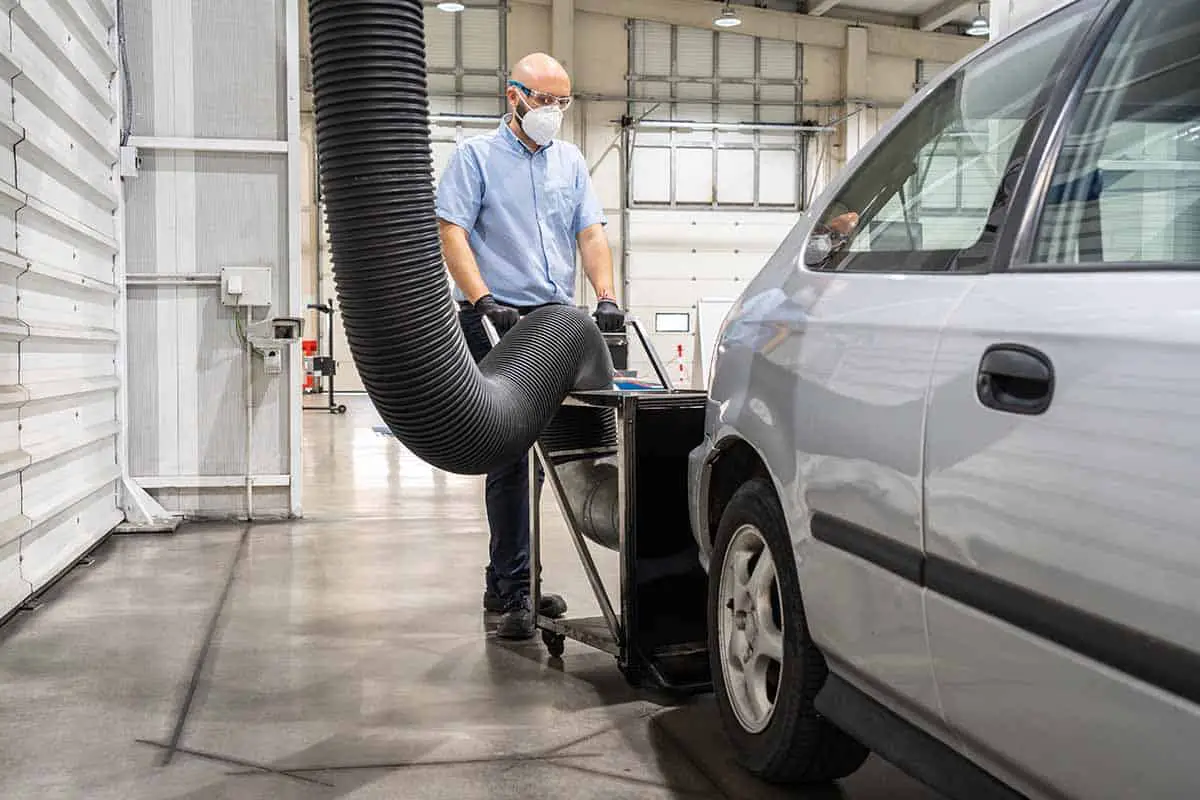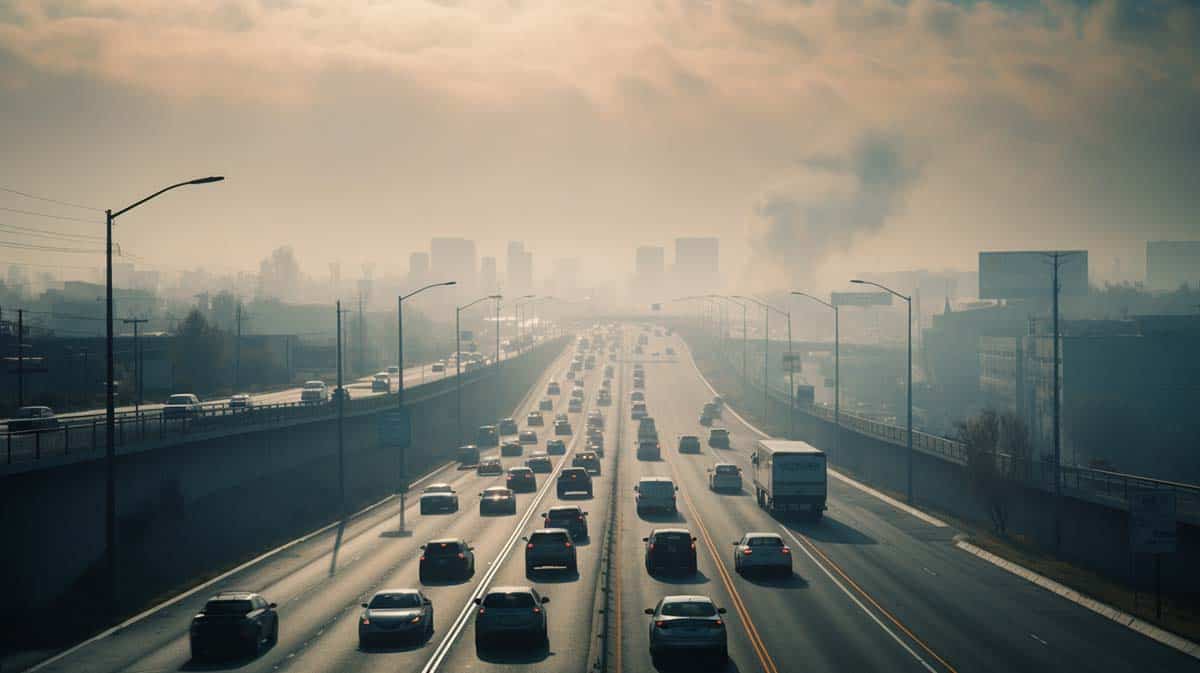The California Car Emission Laws are among the most stringent in the country, making it critical for car owners to understand how they impact their vehicles.
California Department Of Motor Vehicles
The California Department of Motor Vehicles (DMV) plays a crucial role in implementing and enforcing California’s emission laws. As a vehicle owner and California resident, it is essential to stay updated with the state’s strict emissions standards that help improve air quality and protect public health.
The DMV ensures your compliance by requiring regular smog checks based on your car’s model year and type, such as light-duty or medium-duty vehicles.
In some cases, it may be required to replace certain parts like catalytic converters or to install advanced clean technology for better fuel economy and reduced emissions.
California Emissions Standards
The Golden State is known for its strict regulations that apply to all vehicles operating within the state borders and vary depending on factors such as vehicle age, fuel type, and gross vehicle weight rating (GVWR).

Vehicles Subject To California Emissions Standards
It’s important to know which vehicles are subject to California emissions standards as these rules apply not only to residents but also those planning to move or import a vehicle into the state.
Generally, these stringent regulations cover passenger cars, light-duty trucks, and medium-duty vehicles of specific model years.
As an example, let’s imagine you’re moving from Texas with your 2010 Ford Mustang. Before registering your car in California, it needs to pass an inspection that ensures it meets the state’s emission standards.
If your car does not comply with California emissions requirements consult official resources for guidance.
If you’re unsure whether it does or not, consult the Vehicle Emissions Control Information label typically found under the hood of your car. Read the following section for more information.
How To Determine If Your Vehicle Meets California Emissions Standards
As a car owner in California, it’s crucial to know if your vehicle meets the state’s emissions standards. Here are the steps you can follow to determine your vehicle’s compliance with California emissions regulations:
- Locate the “Vehicle Emission Control Information” (VECI) label on your car. This label is typically found under the hood or near the radiator support, and it indicates whether your vehicle complies with federal or California emissions standards.
- Check for a statement on the VECI label that says your vehicle meets California emissions requirements. Phrases like “Certified for sale in California” or “Conforms to California regulations” indicate compliance with state standards.
- If you cannot find the VECI label or it has been damaged, refer to your owner’s manual for information regarding emissions compliance. You may also contact your car manufacturer’s customer service department or visit their website for further assistance.
- Look up your Vehicle Identification Number (VIN) online using services like Carfax or AutoCheck to get detailed information about your car, including its emissions status.
- Seek guidance from emission testing centers in California if you have doubts or concerns about your vehicle’s compliance with state regulations.
Remember, non-compliance with California emission laws can lead to fines and penalties. Ensure that you stay informed about updated regulations and make necessary modifications to maintain compliance with state standards.
Learn about the latest regulations governing smog checks for diesel cars in California with the introduction of the 2023 New California Smog Check Rules.

Compliance With California Emissions Standards And Missing MCO
Proof of vehicle compliance with California emissions standards can be found on the Manufacturer’s Certificate of Origin (MCO) provided at the time of purchase or lease.
You can contact your vehicle manufacturer or visit their website to request a duplicate copy of your MCO. You may also hire an attorney who specializes in this area or seek help from the DMV.
Additional Resources And Information
Fortunately, there are many resources available for people interested in learning more about these emission laws and regulations.
Firstly, the California Air Resources Board (CARB) website provides comprehensive information on emissions standards and compliance requirements for both individuals and businesses.
Additionally, the California Department of Motor Vehicles (DMV) offers online resources such as Smog Check Program updates and guidelines for registering low-emission vehicles.
It is also important to note that emissions testing can be done at various locations throughout the state, including DMV offices and private smog check stations.
What’s Special About California’s Emissions Standards?
California’s emissions standards are stricter than federal requirements, with the state aiming for a 50% reduction in greenhouse gas emissions by 2030 and requiring a certain percentage of zero-emission vehicles to be sold each year.
California’s ultimate goal is achieve 100% clean transport with sales of all new cars being zero-emission vehicles by the year 2035.
Differences And Impact
California’s emissions standards are stricter than federal rules, and they have a significant impact. California has been a leader in promoting clean air policies, and the state’s strict emissions standards are designed to reduce both air pollution and greenhouse gas emissions.
These standards push automakers to produce vehicles that emit fewer pollutants and require them to adopt cleaner technologies. The effects of these regulations go beyond just California; seventeen other states have adopted some or all of California’s standards, meaning tens of millions of people benefit from cleaner air as a result.
Benefits And Implications
The benefits of these regulations include improved air quality and public health, as well as mitigation of global warming.
California has strict rules concerning vehicle emissions standards because air pollution and smog is a major health concern in this state.
Air pollution exacerbates respiratory issues such as asthma and lung cancer as well as other health problems such as heart disease and stroke according to data reported by CARB.
By reducing harmful pollutants that contribute to smog and respiratory illnesses, Californians lead healthier lives.
However, there are implications as well – increased costs for manufacturers can translate into higher prices for new cars on dealership lots.

History And Achievements
California has been at the forefront of regulating vehicle emissions since the 1960s. In fact, they were the first state to require vehicles to have emission control devices.
Since then, California has made major strides in decreasing air pollution through implementing stricter emissions standards than mandated by federal regulations.
States Following California’s Standards
Under Section 177 of the Clean Air Act allows other states to adopt California’s stricter emissions standards.
Here are the states currently following California’s standards:
- Connecticut
- Delaware
- Maine
- Maryland
- Massachusetts
- New Jersey
- New Mexico
- New York
- Oregon
- Pennsylvania
- Rhode Island
- Vermont
- Washington D.C.
- Minnesota (Partial adoption)
- Colorado (Partial adoption)
- Hawaii (Partial adoption)
- Ohio (Partial adoption)
These states have taken their own steps to reduce greenhouse gas emissions by following California’s lead in adopting stricter regulations for vehicles sold within their borders, helping to protect public health and the environment from harmful air pollution and climate change impacts.
Government’s Ability To Remove California’s Standards
As mentioned, the Clean Air Act grants California the power to set its own vehicle emission standards. However, this authority has been challenged over the years.
In 2019, the Trump Administration moved to revoke California’s authority to enforce it’s own rules on car emissions. This decision was met with widespread opposition from environmentalists and several states that follow California’s standards.
This reversal highlights an ongoing debate about whether or not states should be allowed to have their own emissions standards separate from federal regulations.
While some argue that it creates a patchwork of differing regulations across state lines, others believe it allows for greater innovation and progress towards reducing harmful air pollutants like greenhouse gases.
In conclusion, while Californians can currently breathe a sigh of relief knowing their state has regained control over its tougher emission rules, there is still potential for change depending on who holds office at any given time.
California Air Resources Board
The California Air Resources Board is responsible for implementing and enforcing the state’s emission standards, as well as developing programs to encourage low-emission vehicles and reduce air pollution.

About The California Air Resources Board
The California Air Resources Board (CARB) focuses on setting and enforcing vehicle emissions standards to protect public health in California. CARB was established in 1967 and is responsible for meeting the requirements of the federal Clean Air Act as well as implementing state laws that are more stringent than those required by the federal government.
Their primary objective is to reduce air pollution and greenhouse gas emissions from vehicles and promote zero-emission transportation options. In line with this goal, CARB has implemented several programs such as the Low-Emission Vehicle Program and Zero-Emission Vehicle requirement.
Low-Emission Vehicle Program
The California Air Resources Board (CARB) has implemented a Low-Emission Vehicle (LEV) program that requires auto manufacturers to produce cleaner light and heavy-duty vehicles.
The LEV program aims to reduce criteria pollutant emissions and control greenhouse gas emissions by setting stricter standards for vehicle exhaust, fuel systems, and evaporative emissions.
In 1990, the LEV I program was introduced, which evolved into LEV II and III regulations. These programs have successfully reduced vehicle pollution levels in California over the years.
For example, according to CARB data from 2019, new cars sold in California emitted an average of 99% fewer smog-forming pollutants than those sold in the state during 1970s.
Categories of Low-Emission Vehicle
The California Air Resources Board (CARB) has created several categories for low-emission vehicles, each with its own set of requirements. These categories include:
- Zero-Emission Vehicles – Fully electric or hydrogen fuel cell-powered vehicles that produce no emissions and are 100% compliant with California emissions standards.
- Partial Zero-Emission Vehicles – These vehicles are gas-powered cars that produce fewer emissions than traditional gasoline-powered cars but are not fully zero-emission. They must meet specific criteria to be classified as such.
- Advanced Technology Partial Zero-Emission Vehicles – These hybrid-electric vehicles use advanced technology to reduce emissions beyond what is required for partial zero-emission vehicle classification.
- Transitional Zero-Emission Vehicles – These vehicles use alternative fuel sources, including natural gas or propane, and produce fewer emissions than traditional gasoline-powered cars.
- Inherently Low-Emission Vehicles – These vehicles have been designed from the ground up to produce fewer emissions than traditional gas-powered vehicles.
Each category has strict requirements that manufacturers must adhere to in order to meet California’s stringent emissions standards. This ensures that only the cleanest and most environmentally friendly vehicles are sold in the state.
Vehicle Emissions California Waivers And Authorizations
As someone who wants to understand vehicle emission laws in California, it’s important to know about the waiver and authorization processes. Here are some key points:
- California must request authorization from the Administrator of the EPA to enforce its adopted emission control standards and other requirements.
- Under the Clean Air Act Section 209, the Administrator shall not grant a waiver if they find that California’s standards and accompanying enforcement procedures are arbitrary or capricious.
- California has been granted over 100 waivers for various programs, including the Clean Cars Waiver, since the Clean Air Act was enacted.
- Other states can also enforce California’s specified emission standards after California obtains a waiver for those standards under Section 177 of the Clean Air Act.
- Federal and state vehicle emissions and fuel economy standards are set by the EPA, which can grant a waiver if California’s standards are necessary to meet compelling interests.
Federal Register Notices
As part of the vehicle emission laws in California, the Federal Register Notices play a critical role. These notices are released by the federal government and contain information about new regulations or changes to existing ones that impact vehicles and their emissions.
For example, recent Federal Register Notices have covered everything from updates to California’s low-emission vehicle program to waivers granted for certain types of vehicles that may not meet current emissions requirements.
DMV & Emissions Testing Locations In California
California DMV and emissions testing locations are available statewide, enabling vehicle owners to easily comply with the state’s emission standards.
California Smog Check And Emissions Testing
If you live in California, you would have heard of smog checks. Smog checks are state-sponsored programs designed to identify cars that release excessive tailpipe emissions.
The California DMV requires most car sales in the state to pass a smog check or emissions test. There are specific tests that Smog Check Stations must perform in order for a vehicle to pass the inspection, including examining your engine’s computer system and running an evaporative emissions test.
To ensure compliance with regulations, it’s important to review the Emissions Testing and Vehicle Registration FAQ before testing.
Requirements And Exemptions
Understanding the requirements and exemptions for California emissions testing is essential for vehicle owners who want to comply with the state’s stringent regulations. The following table summarizes the key eligibility factors and stipulations for various vehicle types:
| Vehicle Type | Testing Requirements | Exemptions |
|---|---|---|
| Gasoline-powered vehicles | Must complete an emissions test every two years or upon registration renewal. | Exempt if the vehicle is a 1975 model year or older. |
| New residents | Must complete an emissions test before registering their vehicle in California. | Exempt if the vehicle meets certain emissions standards and is accompanied by a valid smog certificate from the previous state. |
| Diesel vehicles | Required to undergo emissions testing. | Exempt if the vehicle is a 1997 model year or older or has a Gross Vehicle Weight Rating (GVWR) of more than 14,000 lbs. |
| Alternative fuel vehicles | Must meet eligibility requirements and pass an eligibility inspection for California’s alternative fuels incentives and laws. | Exemptions vary depending on the specific alternative fuel and vehicle type. |
Be sure to check with the California Department of Motor Vehicles and the California Air Resources Board for the most up-to-date information on emissions testing requirements and exemptions.
Conclusion
In conclusion, understanding California car emission laws is crucial for anyone owning or planning to purchase a vehicle in California. The state has its own strict emissions standards that all vehicles must adhere to, and it’s important to know whether your vehicle meets these requirements.
FAQs:
What are the current California car emission laws and how will they change in 2023?
The current California car emission laws require all vehicles to meet specific standards for reducing greenhouse gas emissions, including limits on nitrogen oxides and particulate matter. In 2023, these requirements will become even more stringent for newer light-duty diesel vehicles.
How can I ensure my vehicle is compliant with California’s car emission laws?
To make sure your vehicle meets California’s current and upcoming emissions standards, you should have it regularly inspected by a licensed technician who can check for any leaks or issues with your engine components or exhaust system. You may also need to upgrade certain parts of your vehicle to meet updated regulations depending on its age or make/model.
Will there be penalties if my vehicle does not comply with these new regulations?
Yes, if your vehicle doesn’t comply with California’s car emission laws then you could face penalties such as fines or even having your registration suspended until the issue is resolved. It is important to stay informed about changes to these laws so that you can remain compliant and avoid any unnecessary expenses or legal issues down the line..
- Tesla Charger Installation Cost (Home Setups) - March 1, 2024
- Tesla Phone Key Disconnected (Troubleshooting Guide and Quick Fixes) - March 1, 2024
- Tesla FSD 12 (Explained) - March 1, 2024